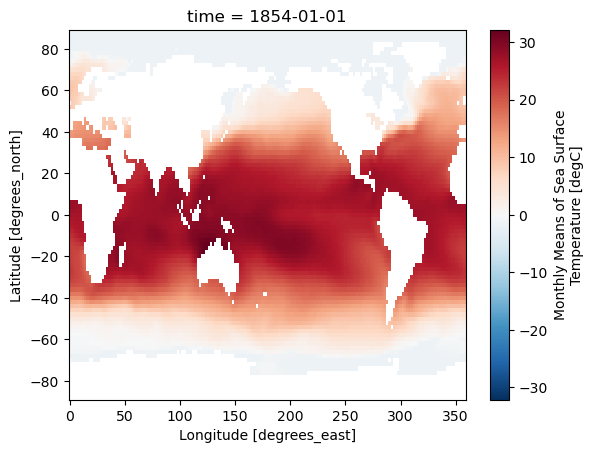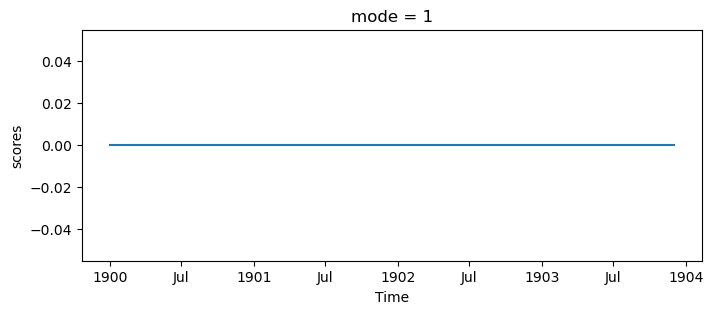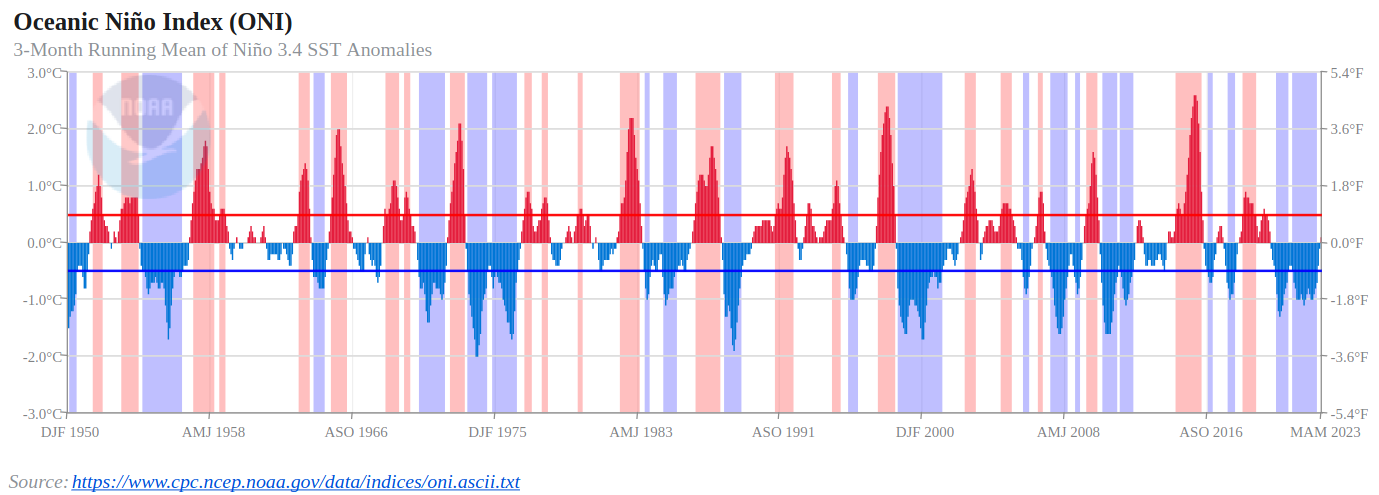Overview¶
In this notebook, we will identify and plot a few different modes of climate variability with the help of an EOF package that interfaces with Xarray called xeofs.
Prerequisites¶
| Concepts | Importance | Notes |
|---|---|---|
| Intro to Xarray | Necessary | |
| Intro to EOFs | Helpful | |
| EOFs with NumPy | Helpful |
Time to learn: 30 minutes
Imports¶
import numpy as np
import xarray as xr
import matplotlib.pyplot as plt
import xeofs as xeAccessing and preparing the data¶
We will use the NOAA Extended Reconstructed Sea Surface Temperature version 5 (ERSSTv5) monthly gridded dataset Huang et al., 2017, which is accessible using OPeNDAP. More information on using OPeNDAP to access NOAA data can be found here.
data_url = 'https://psl.noaa.gov/thredds/dodsC/Datasets/noaa.ersst.v5/sst.mnmean.nc'sst = xr.open_dataset(data_url).sst
sstCheck that the data looks as expected:
sst.isel(time=0).plot()
Before we modify the data, let’s do an EOF analysis on the whole dataset:
s_model = xe.single.EOF(n_modes=4, use_coslat=True)
s_model.fit(sst, dim='time')
s_eofs = s_model.components()
s_pcs = s_model.scores()
s_expvar = s_model.explained_variance_ratio()s_eofs.plot(col='mode')<xarray.plot.facetgrid.FacetGrid at 0x7fe82ef81fd0>
s_pcs.plot(col='mode')<xarray.plot.facetgrid.FacetGrid at 0x7fe82ed747d0>
s_expvarEOF1 explains 83% of the variance, and the map shows interhemispheric asymmetry. The corresponding PC has a period of one year, which we can see more clearly by only plotting a few years:
s_pcs.sel(mode=1, time=slice('1900', '1903')).plot(figsize=(8, 3))
This mode is showing the seasonal cycle. This is interesting, but it obfuscates other modes. If we want to study the other ways Earth’s climate varies, we should remove the seasonal cycle from our data. Here we compute this (calling it the SST anomaly) by subtracting out the average of each month using Xarray’s .groupby() method:
sst_clim = sst.groupby('time.month')
ssta = sst_clim - sst_clim.mean(dim='time')The remaining 3 EOFs show a combination of the long-term warming trend, the seasonal cycle (EOF analyses do not cleanly separate physical modes), and other internal variability. The warming trend is also interesting (see the CMIP6 Cookbook), but here we want to pull out some modes of internal/natural variability. We can detrend the data by removing the global average SST anomaly.
def global_average(data):
weights = np.cos(np.deg2rad(data.lat))
data_weighted = data.weighted(weights)
return data_weighted.mean(dim=['lat', 'lon'], skipna=True)ssta_dt = (ssta - global_average(ssta)).squeeze()Let’s find the global EOFs again but with the deseasonalized, detrended data:
ds_model = xe.single.EOF(n_modes=4, use_coslat=True)
ds_model.fit(ssta_dt, dim='time')
ds_eofs = ds_model.components()
ds_pcs = ds_model.scores()
ds_expvar = ds_model.explained_variance_ratio()ds_eofs.plot(col='mode')<xarray.plot.facetgrid.FacetGrid at 0x7fe82e9de990>
ds_pcs.plot(col='mode')<xarray.plot.facetgrid.FacetGrid at 0x7fe82ed7d0f0>
ds_expvarNow we can see some modes of variability! EOF1 looks like ENSO or IPO, and EOF2 is probably picking up a pattern of the recent temperature trend where the Southern Ocean and southeastern Pacific are slightly cooling. EOF3 and EOF4 appear to be showing some decadal modes of variability (PDO and maybe AMO), among other things. There is a lot going on in each of these maps, so to get a clearer index of some modes, we can restrict our domain.
El Niño Southern Oscillation (ENSO)¶
Here we restrict our domain to the equatorial Pacific. Note that ENSO is commonly defined using an index of SST anomaly over a region of the equatorial Pacific (e.g., the Oceanic Niño Index (ONI)) instead of an EOF. You can read more about ENSO here.
ep_ssta_dt = ssta_dt.where((ssta_dt.lat < 30) & (ssta_dt.lat > -30) & (ssta_dt.lon > 120) & (ssta_dt.lon < 290), drop=True)ep_model = xe.single.EOF(n_modes=4, use_coslat=True)
ep_model.fit(ep_ssta_dt, dim='time')
ep_eofs = ep_model.components()
ep_pcs = ep_model.scores()
ep_expvar = ep_model.explained_variance_ratio()ep_eofs.plot(col='mode')<xarray.plot.facetgrid.FacetGrid at 0x7fe82ed7d350>
ep_pcs.plot(col='mode')<xarray.plot.facetgrid.FacetGrid at 0x7fe82e9c5c70>
ep_expvarfig, ax = plt.subplots(1, 1, figsize=(10, 2), dpi=130)
plt.fill_between(ep_pcs.time, ep_pcs.isel(mode=0).where(ep_pcs.isel(mode=0) > 0), color='r')
plt.fill_between(ep_pcs.time, ep_pcs.isel(mode=0).where(ep_pcs.isel(mode=0) < 0), color='b')
plt.ylabel('PC')
plt.xlabel('Year')
plt.xlim(ep_pcs.time.min(), ep_pcs.time.max())
plt.grid(linestyle=':')
plt.title('ENSO Index (detrended equatorial Pacific SSTA EOF1)')
Compare to the ONI:
fig, ax = plt.subplots(1, 1, figsize=(10, 2), dpi=130)
plt.fill_between(ep_pcs.time, ep_pcs.isel(mode=0).where(ep_pcs.isel(mode=0) > 0), color='r')
plt.fill_between(ep_pcs.time, ep_pcs.isel(mode=0).where(ep_pcs.isel(mode=0) < 0), color='b')
plt.ylabel('PC')
plt.xlabel('Year')
plt.xlim(ep_pcs.time.sel(time='1950-01').squeeze(), ep_pcs.time.max())
plt.grid(linestyle=':')
plt.title('ENSO Index (detrended equatorial Pacific SSTA EOF1)')

Pacific Decadal Oscillation (PDO)¶
Here we restrict our domain to the North Pacific. You can read more about PDO here.
np_ssta_dt = ssta_dt.where((ssta_dt.lat < 70) & (ssta_dt.lat > 20) & (ssta_dt.lon > 120) & (ssta_dt.lon < 260), drop=True)np_model = xe.single.EOF(n_modes=4, use_coslat=True)
np_model.fit(np_ssta_dt, dim='time')
np_eofs = np_model.components()
np_pcs = np_model.scores()
np_expvar = np_model.explained_variance_ratio()np_eofs.plot(col='mode')<xarray.plot.facetgrid.FacetGrid at 0x7fe82e9c5d90>
np_pcs.plot(col='mode')<xarray.plot.facetgrid.FacetGrid at 0x7fe82e9c68d0>
np_expvarfig, ax = plt.subplots(1, 1, figsize=(10, 2), dpi=130)
plt.fill_between(np_pcs.time, np_pcs.isel(mode=0).where(np_pcs.isel(mode=0) > 0), color='r')
plt.fill_between(np_pcs.time, np_pcs.isel(mode=0).where(np_pcs.isel(mode=0) < 0), color='b')
plt.plot(np_pcs.time, np_pcs.isel(mode=0).rolling(time=48, center=True).mean(), color='k', linewidth=2)
plt.ylabel('PC')
plt.xlabel('Year')
plt.xlim(np_pcs.time.min(), np_pcs.time.max())
plt.grid(linestyle=':')
plt.title('PDO Index (detrended North Pacific SSTA EOF1)')
Summary¶
In this notebook, we demonstrated a basic workflow for performing an EOF analysis on gridded SST data using the xeofs package. We plotted the PCs associated with ENSO and PDO using deseasonalized, detrended SSTs.
What’s next?¶
In the future, additional notebooks may use EOFs to recreate published figures, give an overview of other EOF packages, or explore variations of the EOF method.
Resources and references¶
Scientific description of the ERSSTv5 data set: Huang et al. (2017), doi:10.1175/jcli-d-16-0836.1
Paper describing the xeofs software: Rieger et al., (2024) doi:10.21105/joss.06060
- Huang, B., Thorne, P. W., Banzon, V. F., Boyer, T., Chepurin, G., Lawrimore, J. H., Menne, M. J., Smith, T. M., Vose, R. S., & Zhang, H.-M. (2017). Extended Reconstructed Sea Surface Temperature, Version 5 (ERSSTv5): Upgrades, Validations, and Intercomparisons. Journal of Climate, 30(20), 8179–8205. 10.1175/JCLI-D-16-0836.1
- Rieger, N., & Levang, S. J. (2024). xeofs: Comprehensive EOF analysis in Python with xarray. Journal of Open Source Software, 9(93), 6060. 10.21105/joss.06060